【by FUNG Wan Yin Kimberly, June 2023】
Matsuki Village was demolished in 1902 and became a deserted land due to damage caused by the sulfurous acid gases emitted from the refining process of sulfurous copper ores in Ashio.[1] The smoke-related damage is extensive in Ashio. As the toxic smoke killed trees, there were no longer any roots to hold the topsoil, leaving it to be washed away by rain.[2] Mountains in Ashio turned barren with their bedrock exposed.
Despite the return of greenery over the past 120 years, recovering the forested areas has been an ongoing challenge due to deteriorated soil and other factors such as deer overpopulation and climate change. The Matsuki tailing dam of black copper slag built in 1912 in the old Matsuki Village[3] also shows no signs of planned abolishment. A “complete” regeneration of the entire field is deemed unattainable.
Forest People Project (森びとプロジェクト), a voluntary organization tackling climate change through reforestation, started a reforestation project in the old Matsuki Village in 2004. “If you are going to make forests, do it in the most difficult places.” Members of the Forest People Project were told by their advisor, Akira Miyawaki, a vegetation ecologist. These words led them to the old Matsuki Village and other difficult sites, including other abandoned mines and ruins of the 3.11 tsunami.
How to hope in the ongoing aftermath of industrial pollution if neither an instant exit nor a finishing line is available? In this essay, I argue that hope is not an absence of toxins or a complete environmental recovery that reverses the arrow of time as if copper mining and refinery had never happened in Ashio. By discussing my fieldwork conducted with Forest People Project, I discuss how volunteers locate and plant hope amid damaged mountains and ruined lands.
Figuring Hope in Plants
Entering the old Matsuki Village, there is a sea of pasture. I first mistook weeping love grass (シナダレスズメガヤ) for Japanese pampas grass (ススキ). Both are species commonly found in Ashio because they were pioneer species used for rapid greening[4] and spread monstrously, sometimes hindering the growth of trees and, thus, reforestation. I was told that the presence of pampas grass would be a better sign for recovery than the weeping lovegrass, a kind of “foreign pasture species (外来牧草).” While pampas grass was also planted artificially as the pasture species were, it outgrew pasture in places with generally more favorable soil conditions. According to a former Forestry Agency official, “Pampas grass grew at places where acidic soil was improved, where pasture once grew and died.” The presence of pampas grass implies a more favorable soil condition for the growth of other plants.
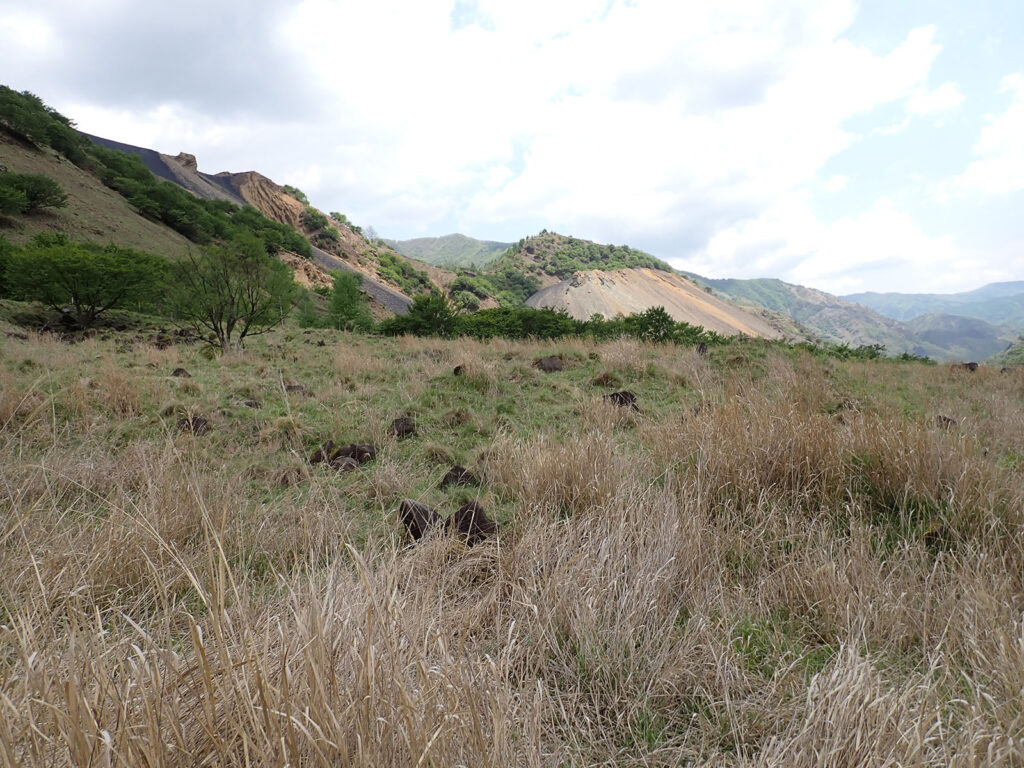
The old Matsuki Village with the tailing dam of copper slag in the background. (April 2022)
I was surprised that pampas grass might be read in a hopeful light as it was often viewed as a hindrance to reforestation. Much of my time spent in reforestation volunteering for another organization was digging up and throwing away the hardy roots of pampas grass so that young trees would not die from insufficient nutrients. The roots, sometimes with shades of red like blood veins, grew so extensively over the field and tangled with retaining walls that often, I lacked the strength and skill to shovel the main root system. The twisting roots were closer to the “monster” figure than an indicator of soil improvement.[5] On the other hand, to my knowledge, the volunteer organizations of reforestation in Ashio would not grow pampas grass as their goal is not rapid greening but forest making, though judgment towards the history of the prevailing use of pampas grass in greening would be another debate.
The sea of pasture is rendered as evidence of the necessity of human involvement: “Grassland remains as grassland if left uncared.” As Eben Kirksey, Nicholas Shapiro, and Maria Brodine argued, blasted toxic landscapes can also provide new figures of hope.[6] And just as pampas grass can be both evidence of improved soil and obstruction, reading into the presence of living things is a way to figure hope in living things and generate action: the footsteps and feces of bears, rabbits, monkeys, and deer can be, at the same time, a hopeful sign of the return of living things and a worrying alert that young trees might be eaten before growing strong enough to withstand the bites from wild animals, thus requiring a change of fencing strategies.
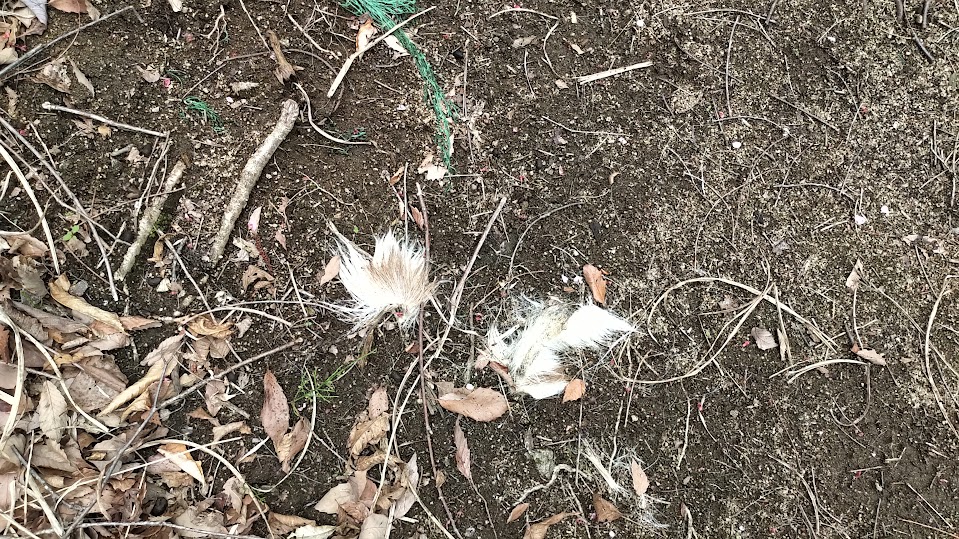
Deer fur found on the ground in the reforestation area (April 2022)
Planting Hope
Regarding tree species to be planted in the old Matsuki Village, the Forest People Project draws on the field research conducted by Akira Miyawaki, a vegetation ecologist who developed forest regeneration methods through the theory of potential natural vegetation. The ecological engineering based on potential natural vegetation does not follow the classical succession theory of vegetation transforming from herb community to the climax community by Frederic Clements. Instead, it aims to speed up the vegetation succession to a “quasi-natural forest” within several decades by planting plant species that would exist if not disturbed by human activities and are in equilibrium with climate at a given location.[7]
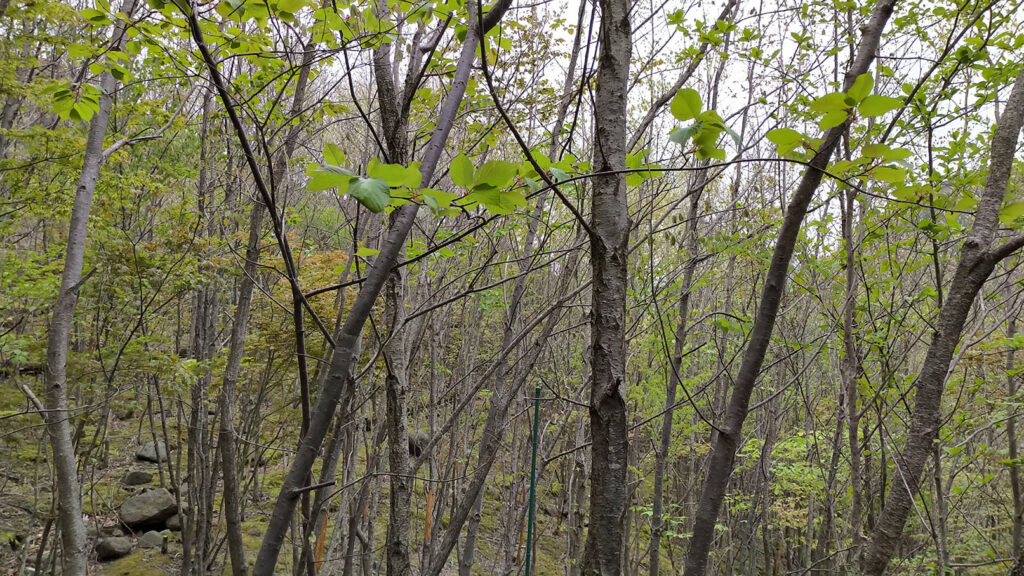
One of the forests the Forest People Project manages (April 2022)
A mixture of several species of deciduous broadleaved trees, such as konara oak (コナラ), mizunara oak (ミズナラ), Japanese horse-chestnut (トチノキ), katsura (カツラ), and Japanese maple (ヤマモミジ, イロハモミジ), was identified as the potential natural vegetation species and was densely planted in designated reforestation areas.[8] In autumn, the blend of yellow and red contrasted sharply with the surrounding brownish Alnus firma (ヤシャブシ). Their seeds were spread by helicopters in the 1960s as pioneer reforestation species selected by the administration[9] due to their ability of nitrogen fixation. The contrast of color reflects the distinction between single-species reforestation and diverse forest community. I was reminded of “the different kinds of green” and that the simple return of green may not always be a sign of regeneration.
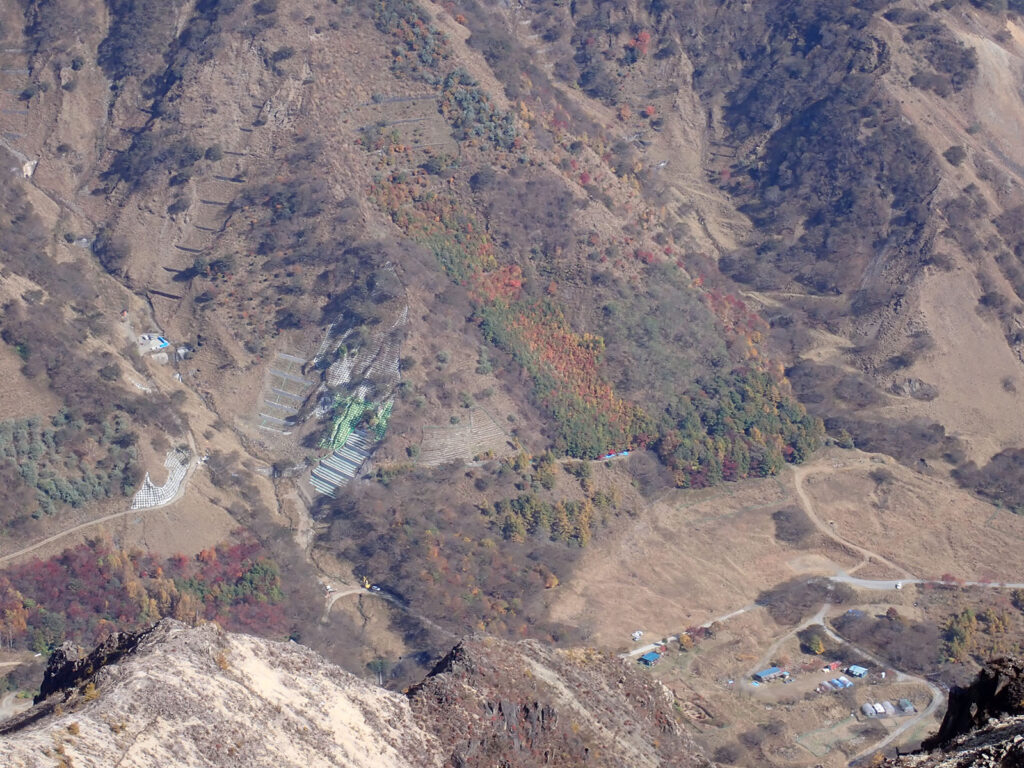
In the middle was the forest in the last photo with yellow and red maple leaves during autumn (November 2022)
Moving on from the theory of potential natural vegetation, the group started a new experiment with the remaining land they had permission to grow trees. Dividing the land into areas according to the soil condition, they selected the species accordingly for observation. They planned to record the vegetation succession to generate new insights for reforestation projects in other degraded lands. If potential natural vegetation is a theory of “what might have been,” this recent attempt would be to observe “what is yet possible to be.” Both are ways of finding hope for a livable future by experimenting with what remains possible in the polluted present.
The newly designated areas for reforestation were named “Rinne Forest (りんねの森),” or “the forest of reincarnation (りんね is the hiragana for the kanji 輪廻),” “in the hope that people will be able to sense the reincarnation of all living things in a land that has only grass and no trees for more than half a decade.”[10]
Hoping for a Japanese Beech
In 2013, some mountain hikers informed members of a stand-alone tree, species unconfirmed, on the top of Mt. Nakakura. The stand-alone tree on the top of Mt. Nakakura was later identified as a 120-year-old Japanese beech. Mt. Nakakra was one of the mountains severely affected by smoke pollution. One mountainside had barely any vegetation due to sulfurous acid emissions. While the other side is vegetated, many of the trees are not native species under the potential natural vegetation theory but Japanese clethra (リョウブ), a species with high heavy-metal tolerance that was selected as the pioneer reforestation species like Alnus firma.[11]
The Japanese beech implies that there was probably a forest of beech where many of them died due to the acidic fumes. As beech usually grows in humid forests with large water retention capacities, the “Lone Japanese Beech” (孤高のブナ) living through the unfavorable conditions of Mt Nakakura is then a survival tree, a “silent story-telling tree” (無言の語り木), and a “living witness” (生き証人) of the history of smoke pollution and the demolishment of Matsuki Village.
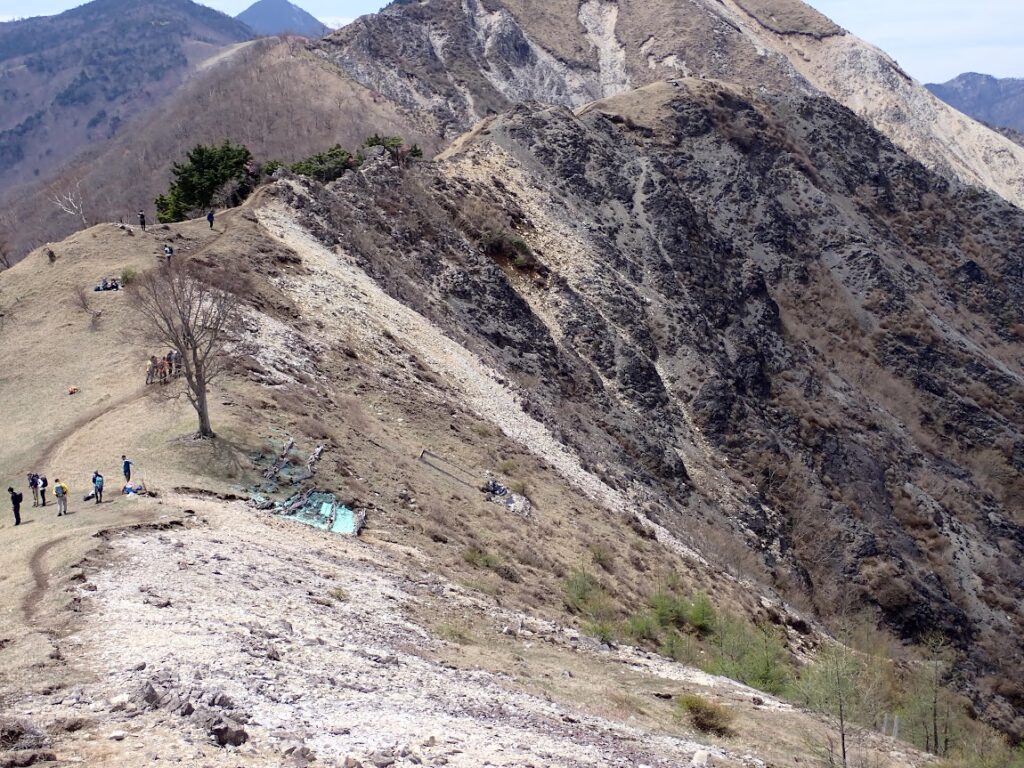
Mt. Nakakura and the Lone Japanese Beech (April 2023)
Although the beech survived the smoke pollution, the severe soil erosion on that side of the mountain caused its roots to be exposed to bare ground. In addition, without the protection of other trees, the lone beech is also prone to wind scorch and sunscald. Forest People Project then started a conservation project for the Japanese Beech on Mt. Nakakura in 2017 called “Pay it forward: Cheering up the Japanese Beech on Mt. Nakakura, Ashio (足尾・中倉山のブナを元気にする恩送り).”
Forest People Project organizes volunteers to carry black soil to the mountaintop twice yearly. Volunteers fill the vegetation bags (植生袋) with black soil and pin the bags around the exposed roots, hoping grass would grow and slow down the sediment outflow. Notably, vegetation blocks and bags were adopted for greening in Ashio in 1952 and 1964, respectively,[12] so workers and women from the community could shoulder them and place them on steep, rocky, exposed areas without a rich layer of topsoil.[13]
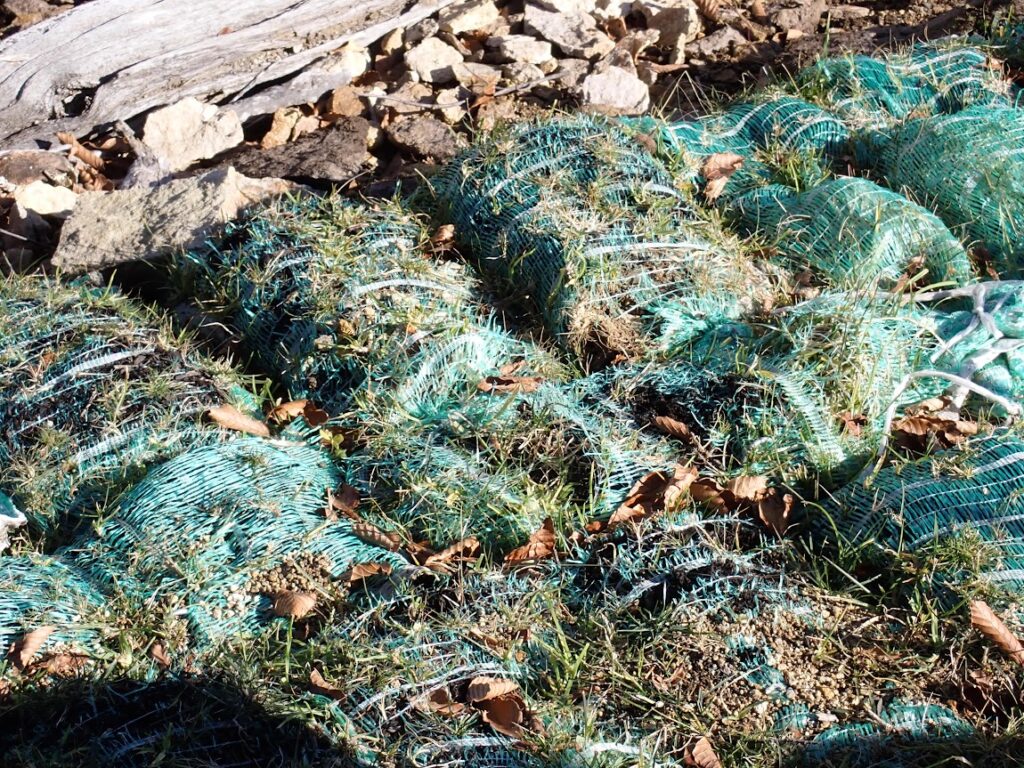
Grass budding from vegetation bags (November 2022)
“It might be that our feelings and cheerings have been heard.” In autumn 2022, the beech had a good harvest year and provided us with many of its seeds. Out of hundreds of picked seeds, a few young beeches budded, some were planted in the reforestation area in the old Matsuki Village, and one was to be planted on Mt. Nakakura in April 2023. Volunteers carried the young beech, animal-repellent net, iron pillars, and wires to the mountaintop. The net was set up with rocks and fallen barks to protect the young tree from being eaten by deer and give it the space and time it needed to grow.
The young beech planted on Mt. Nakakura was named “The Hope of Japanese Beech (希望のブナ).” When I asked what “hope” meant, I was told that “the lone beech does not have its own child, so to plant its child carrying its DNA is hope.” As the life of the lone beech may end any day, they wished its child could “carry hope forward.” This hope is not that of environmental regeneration (though desirable) but of witnessing and telling history forward. From this point of view, hope is not confined to the potential and the possible environmental regeneration. Caring for the witness of pollution is also hope.

The Hope of Japanese Beech inside the animal repellent net (April 2023)
Hope in the present
In pursuing an alternative discourse against damaged-based research, which renders lives and landscapes pathological, Michelle Murphy proposed the concept of “alterlife”:
“Alterlife embraces impure and damaged forms of life, pessimistically acknowledging ongoing violence, living within and against the worlds technoscience helped make. Alterlife is resurgent life, which asserts and continues nonetheless. […] Alterlife acknowledges that one cannot simply get out, that this hurtful and deadly entanglement forms part of contemporary existence in this moment, in the ongoing aftermath. And yet the openness to alteration may also describe the potential to become something else, to defend and persist, to recompose relations to water and land, to become alter-wise in the aftermath.”[14]
So, once again, how to hope when the aftermath of industrial pollution is irreparable? As demonstrated by the Forest People Project’s reforestation efforts in the old Matsuki Village, hope can be located in the present amid the damaged mountains and lands. Forest People Project transforms patches of industrial ruin into forests as a way to put a brake on climate change. The human-plant interactions de/recompose the abandoned land into hopes: hope as environmental regeneration and hope as witnessing. By hoping for the Japanese beech, hope is in the present, right in the center of an ongoing aftermath of industrial pollution. Hope is now. The Japanese beech and the newly planted young trees are right here in the damaged landscape.
“Plants cannot move; they stay where they are when we plant them. So, please make sure we plant properly.” I was often reminded that trees would not walk, and they give all they have to live on the spot. Sometimes animals disperse the seeds, and sometimes they bite off the budding tree. We do all we can to work with the other species, then we hope (祈り) and try again.
AUTHOR
FUNG Wan Yin Kimberly, PhD Student of Anthropology, Hitotsubashi University, Japan
NOTES
[1] Nobiko Ijima, Mining Pollution in the Ashio Copper Mine Area (足尾銅山山元における鉱害), United Nations University Press, 1982.
[2] Kichiro Shoji and Masuro Sugai, “The Ashio Copper Mine Pollution Case: The Origins of Environmental Destruction,” in Industrial Pollution in Japan, edited by Jun Ui, United Nations University Press, 1992, pp. 18–63.
[3] Kichiro Shoji and Masuro Sugai, A Concise History of the Ashio Mine Poisoning Incident, 1877-1984 [New Edition] (【新版】通史・足尾鉱毒事件1877~1984), Seori-shobo, 2014, p.231.
[4] For instance, the species were used in vegetation blocks (植生盤), which was invented in 1951 and adopted in 1952. They were also used in aerial seeding that started in 1965. See Masao Harasawa, “Greening of Barren Mountains in Ashio” (足尾荒廃山地の緑化), Journal of the Japan Society of Erosion Control Engineering 51, no. 5 (1999), p. 75. See also Katsuaki Takanashi and Tomoo Oshima, “The Reviving Forests of Devastated Land in Ashio Forest Conservation Projects in Ashio“ (足尾荒廃地の緑の復元:足尾治山事業), Water Science 59, no. 1 (2015): p. 139.
[5] Anna Tsing, Heather Swanson, Elaine Gan and Nils Bubandt, edited, Arts of Living on a Damaged Planet: Ghosts and Monsters of the Anthropocene, University of Minnesota Press, 2017.
[6] Eben Kirksey, Nicolars Shapiro and Maria Brodine, “Hope in Blasted Landscapes,” in The Multispecies Salon, edited by Eden Kirksey, Duke University Press, 2014, pp. 29–63.
[7] Akira Miyawaki, Planting 300,000 Trees: Making a Forest of Life (苗木三〇〇〇万本: いのちの森を生む), Japan Broadcast Publishing, 2006.
[8] Committee of Forest People Project, Five-Year Reforestation Report (5年間の森づくり報告), Forest People Project, 2010. See also Committee of Forest People Project, Ashio-Usuzawa Forest Observation Report (足尾・臼沢の森観察報告書), Forest People Project. 2015.
[9] Takanashi and Oshima (2015), p. 139.
[10] “For the First Time in Four Years, Tree-Planting Was Held in the Rinne Forest” (4年振りの植樹を「りんねの森」で開催しました), Forest People Project, October 1, 2022, http://blog.moribito.info/2022/10/post-34d9.html.
[11] Takanashi and Oshima (2015), p. 139.
[12] Takanashi and Oshima (2015), pp. 135–139.
[13] Local Vitalization Cooperator in Ashio, Nikko, edited, Excuse Me, Can You Tell Me about Ashio? Part Two (ごめんください、足尾のこと教えてください!その2), Nikko Shiyakusho Ashio Sogoshisho, 2016, pp. 5–28.
[14] Michelle Murphy, “Alterlife and Decolonial Chemical Relations,” Cultural Anthropology, 32 no.4 (2017), p. 500.
BIBLIOGRAPHY
Committee of Forest People Project. Five-Year Reforestation Report (5年間の森づくり報告). Forest People Project, 2010.
——Ashio-Usuzawa Forest Observation Report (足尾・臼沢の森観察報告書). Forest People Project, 2015.
Forest People Project. “For the First Time in Four Years, Tree-Planting Was Held in the Rinne Forest” (4年振りの植樹を「りんねの森」で開催しました). October 1, 2022. http://blog.moribito.info/2022/10/post-34d9.html.
Harasawa, Masao. “Greening of Barren Mountains in Ashio” (足尾荒廃山地の緑化). Journal of the Japan Society of Erosion Control Engineering 51, no. 5 (1999), pp. 72–77.
Ijima, Nobiko. Mining Pollution in the Ashio Copper Mine Area (足尾銅山山元における鉱害). United Nations University, 1982.
Kirksey, Eben, Nicolars Shapiro and Maria Brodine. “Hope in Blasted Landscapes.” In The Multispecies Salon, edited by Eden Kirksey, pp. 29–63. Duke University Press, 2014.
Local Vitalization Cooperator in Ashio, Nikko, edited. Excuse Me, Can You Tell Me about Ashio? Part Two (ごめんください、足尾のこと教えてください!その2). Nikko Shiyakusho Ashio Sogoshisho, 2016.
Miyawaki, Akira. Planting 300,000 Trees: Making a Forest of Life (苗木三〇〇〇万本: いのちの森を生む). Japan Broadcast Publishing, 2006.
Murphy, Michelle. “Alterlife and Decolonial Chemical Relations.” Cultural Anthropology, 32 no.4 (2017), p. 494–503.
Shoji, Kichiro and Masuro Sugai. “The Ashio Copper Mine Pollution Case: The Origins of Environmental Destruction.” In Industrial Pollution in Japan, edited by Jun Ui, pp. 18–63. United Nations University Press, 1992.
——. A Concise History of the Ashio Mine Poisoning Incident, 1877-1984 [New Edition] (【新版】通史・足尾鉱毒事件1877~1984). Seori-shobo, 2014.
Takanashi, Katsuaki and Tomoo Oshima. “The Reviving Forests of Devastated Land in Ashio Forest Conservation Projects in Ashio” (足尾荒廃地の緑の復元:足尾治山事業). Water Science 59, no. 1 (2015): pp. 126–44.
Tsing, Anna, Heather Swanson, Elaine Gan and Nils Bubandt, edited. Arts of Living on a Damaged Planet: Ghosts and Monsters of the Anthropocene. University of Minnesota Press, 2017.